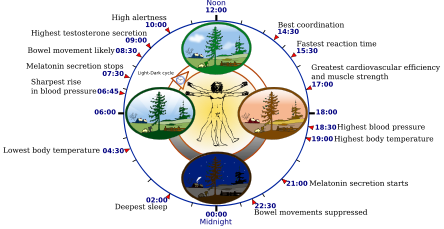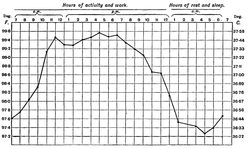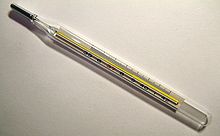- Normal human body temperature
-
"98.6" redirects here. For other uses, see 98.6 (disambiguation).
Normal human body temperature, also known as normothermia or euthermia, is a concept that depends upon the place in the body at which the measurement is made, and the time of day and level of activity of the person. There is no single number that represents a normal or healthy temperature for all people under all circumstances using any place of measurement.
Different parts of the body have different temperatures. Rectal and vaginal measurements, or measurements taken directly inside the body cavity, are typically slightly higher than oral measurements, and oral measurements are somewhat higher than skin temperature. The commonly accepted average core body temperature (taken internally) is 37.5 °C (99.5 °F). The typical oral (under the tongue) measurement is slightly cooler, at 37.0±0.5 °C, or 98.6±0.9 °F.[1][2] Although some people think of these numbers as representing the normal temperature, a wide range of temperatures has been found in healthy people.[3] In samples of normal adult men and women, the observed range for oral temperature is 33.2–38.2 °C (92–101 °F), for rectal it is 34.4–37.8 °C (94–100 °F), for the tympanic cavity it is 35.4–37.8 °C (96–100 °F) and for axillary it is 35.5–37.0 °C (96–99 °F).[4]
 Variations in body temperature are part of the circadian rhythm (see at 4:30 and 19:00).
Variations in body temperature are part of the circadian rhythm (see at 4:30 and 19:00).
The time of day and other circumstances also affects the body's temperature. The core body temperature of an individual tends to have the lowest value in the second half of the sleep cycle; the lowest point, called the nadir, is one of the primary markers for circadian rhythms. The body temperature also changes when a person is hungry, sleepy, or cold.
Contents
History
In the early 18th century, Daniel G. Fahrenheit originally used human body temperature as a reference point for his temperature scale, defining it to be 96°F. Later redefinition of his scale to use the boiling point of water as a reference point caused the numerical value for normal body temperature to drift.
In 1861, Carl Reinhold August Wunderlich released his summary of the armpit, or axillary, temperatures of twenty five thousand people, and reported the mean to be 37.0 °C (98.6 °F), with a range of 36.25 °C (97.25 °F) to 37.5 °C (99.5 °F)[5][1]. He also identified the natural variations in temperature throughout the day and the variations between individuals, as well as differences based on sex and age, which were largely ignored in favor of an oversimplified single number.[6] Wunderlich's thermometers were not calibrated to a standard setting—in 1861, no standard had been agreed upon—and he never explained his methods for compiling and describing the data he had collected, which would have been a monumental task before the availability of basic calculating machines.[6] The one surviving, hand-made thermometer reads significantly higher than modern thermometers.[6]
Variations
Temperature control (thermoregulation) is part of a homeostatic mechanism that keeps the organism at optimum operating temperature, as it affects the rate of chemical reactions. In humans the average oral temperature is 36.8 °C (98.2 °F), though it varies among individuals. However, no person always has exactly the same temperature at every moment of the day. Temperatures cycle regularly up and down through the day, as controlled by the person's circadian rhythm. The lowest temperature occurs about two hours before the person normally wakes up. Additionally, temperatures change according to activities and external factors.[7]
Normal body temperature may differ as much as 0.5 °C (0.9 °F) from day to day.
Natural rhythms
Body temperature normally fluctuates over the day, with the lowest levels around 4 a.m. and the highest in the late afternoon, around 4:00 p.m.[1][8] (assuming the person sleeps at night and stays awake during the day). Therefore, an oral temperature of 37.2 °C (99.0 °F) would, strictly speaking, be normal in the afternoon but not in the morning. An individual's body temperature typically changes by about 0.5 °C (0.9 °F) between its highest and lowest points each day.[1]
Body temperature is sensitive to many hormones, so women have a temperature rhythm that varies with the menstrual cycle, called a circamensal rhythm.[7] A woman's basal body temperature rises sharply after ovulation, as estrogen production decreases and progesterone increases. Fertility awareness programs use this predictable change to identify when a woman is able to become pregnant. During the luteal phase of the menstrual cycle, both the lowest and the average temperatures are slightly higher than during other parts of the cycle. However, the amount that the temperature rises during each day is slightly lower than typical, so the highest temperature of the day is not very much higher than usual.[6] Hormonal contraceptives both suppress the circamensal rhythm and raise the typical body temperature by about 0.6 °C (1.1 °F).[7]
Temperature also varies with the change of seasons during each year. This pattern is called a circannual rhythm.[6] Studies of seasonal variations have produced inconsistent results. People living in different climates may have different seasonal patterns.
Increased physical fitness increases the amount of daily variation in temperature.[6]
With increased age, both average body temperature and the amount of daily variability in the body temperature tend to decrease.[6] Elderly patients may have a decreased ability to generate body heat during a fever, so even a somewhat elevated temperature can indicate a serious underlying cause in geriatrics.
Variations due to measurement methods
Different methods used for measuring temperature produce different results.
Generally, oral, rectal, gut, and core body temperatures, although slightly different, are well-correlated, with oral temperature being the lowest of the four.
Oral temperatures are influenced by drinking, chewing, smoking, and breathing with the mouth open. Cold drinks or food reduce oral temperatures; hot drinks, hot food, chewing, and smoking raise oral temperatures.[7]
Axillary (armpit), tympanic (ear), and other skin-based temperatures correlate relatively poorly with core body temperature.[6] Tympanic measurements run higher than rectal and core body measurements, and axillary temperatures run lower.[6] The body uses the skin as a tool to increase or decrease core body temperature, which affects the temperature of the skin. Skin-based temperatures are more variable than other measurement sites.[6] The peak daily temperature for axillary measurements lags about three hours behind the rest of the body.[6] Skin temperatures are also more influenced by outside factors, such as clothing and air temperature.
Variations due to outside factors
Many outside factors affect the measured temperature as well. "Normal" values are generally given for an otherwise healthy, non-fasting adult, dressed comfortably, indoors, in a room that is kept at a normal room temperature (22.7 to 24.4 °C or 73 to 76 °F), during the morning, but not shortly after arising from sleep. Furthermore, for oral temperatures, the subject must not have eaten, drunk, or smoked anything in at least the previous fifteen to twenty minutes, as the temperature of the food, drink, or smoke can dramatically affect the reading.
Temperature is increased after eating or drinking anything with calories. Caloric restriction, as for a weight-loss diet, reduces overall body temperature.[7] Drinking alcohol reduces the amount of daily change, slightly lowering daytime temperatures and noticeably raising nighttime temperatures.[7]
Exercise raises body temperatures. In adults, a noticeable increase usually requires strenuous exercise or exercise sustained over a significant time. Children develop higher temperatures with milder activities, like playing.
Psychological factors also influence body temperature: a very excited person often has an elevated temperature.
Wearing more clothing slows daily temperature changes and raises body temperature.[7] Similarly, sleeping with an electric blanket raises the body temperature at night.[7]
Sleep disturbances also affect temperatures. Normally, body temperature drops significantly at a person's normal bedtime and throughout the night. Short-term sleep deprivation produces a higher temperature at night than normal, but long-term sleep deprivation appears to reduce temperatures.[7] Insomnia and poor sleep quality are associated with smaller and later drops in body temperature.[7] Similarly, waking up unusually early, sleeping in, jet lag and changes to shift work schedules may affect body temperature.[7]
Specific temperature concepts
Fever
Main article: FeverA temperature setpoint is the level at which the body attempts to maintain its temperature. When the setpoint is raised, the result is a fever. Most fevers are caused by infectious disease and can be lowered, if desired, with antipyretic medications.
An organism at optimum temperature is considered afebrile or apyrexic, meaning "without fever". If temperature is raised, but the setpoint is not raised, then the result is hyperthermia.
Hyperthermia
Main article: HyperthermiaHyperthermia occurs when the body produces or absorbs more heat than it can dissipate. It is usually caused by prolonged exposure to high temperatures. The heat-regulating mechanisms of the body eventually become overwhelmed and unable to deal effectively with the heat, causing the body temperature to climb uncontrollably. Hyperthermia at or above about 40 °C (104 °F) is a life-threatening medical emergency that requires immediate treatment. Common symptoms include headache, confusion, and fatigue. If sweating has resulted in dehydration, then the affected person may have dry, red skin.
In a medical setting, mild hyperthermia is commonly called heat exhaustion or heat prostration; severe hyperthermia is called heat stroke. Heat stroke may come on suddenly, but it usually follows the untreated milder stages. Treatment involves cooling and rehydrating the body; fever-reducing drugs are useless for this condition. This may be done through moving out of direct sunlight to a cooler and shaded environment, drinking water, removing clothing that might keep heat close to the body, or sitting in front of a fan. Bathing in tepid or cool water, or even just washing the face and other exposed areas of the skin, can be helpful.
With fever, the body's core temperature rises to a higher temperature through the action of the part of the brain that controls the body temperature; with hyperthermia, the body temperature is raised without the consent of the heat control centers.
Hypothermia
Main article: HypothermiaIn hypothermia, body temperature drops below that required for normal metabolism and bodily functions. In humans, this is usually due to excessive exposure to cold air or water, but it can be deliberately induced as a medical treatment. Symptoms usually appear when the body's core temperature drops by 1-2 °C (1.8-3.6 °F) below normal temperature.
Basal body temperature
Main article: Basal body temperatureBasal body temperature is the lowest temperature attained by the body during rest (usually during sleep). It is generally measured immediately after awakening and before any physical activity has been undertaken, although the temperature measured at that time is somewhat higher than the true basal body temperature. In women, temperature differs at various points in the menstrual cycle, and this can be used for family planning.
Core temperature
Core temperature, also called core body temperature, is the operating temperature of an organism, specifically in deep structures of the body such as the liver, in comparison to temperatures of peripheral tissues. Core temperature is normally maintained within a narrow range so that essential enzymatic reactions can occur. Significant core temperature elevation (hyperthermia) or depression (hypothermia) that is prolonged for more than a brief period of time is incompatible with human life.
Temperature examination in the rectum is the traditional gold standard measurement used to estimate core temperature (oral temperature is affected by hot or cold drinks and mouth-breathing). Rectal temperature is expected to be approximately one Fahrenheit degree higher than an oral temperature taken on the same person at the same time. Ear thermometers measure eardrum temperature using infrared sensors. The blood supply to the tympanic membrane is shared with the brain. However, this method of measuring body temperature is not as accurate as rectal measurement and has a low sensitivity for fevers, missing three or four out of every ten fevers in children.[9] Ear temperature measurement may be acceptable for observing trends in body temperature but is less useful in consistently identifying fevers.
Until recently, direct measurement of core body temperature required surgical insertion of a probe, so a variety of indirect methods have commonly been used. While the rectal or vaginal temperature is generally considered to give the most accurate assessment of core body temperature, particularly in hypothermia, its recording is disliked by patients and medical staff alike. In the early 2000s, ingestible thermistors in capsule form were produced, allowing the temperature inside the digestive tract to be transmitted to an external receiver; one study found that these were comparable in accuracy to rectal temperature measurement.[10]
Methods of measurement
Taking a patient's temperature is an initial part of a full clinical examination. Sites used for measurement include:
- In the anus (rectal temperature)
- In the mouth (oral temperature)
- Under the arm (axillary temperature)
- In the ear (tympanic temperature)
- In the vagina (vaginal temperature)
- On the skin of the forehead
- Over the temporal artery
- In the gut (by swallowing a small thermometer)
The temperature reading depends on which part of the body is being measured. The typical daytime temperatures among healthy adults are as follows:
- Temperature in the anus (rectum/rectal), vagina, or in the ear (otic) is about 37.5 °C (99.5 °F)[2]
- Temperature in the mouth (oral) is about 37.0 °C (98.6 °F)[1]
- Temperature under the arm (axillary) is about 36.5 °C (97.7 °F) [2]
Normal human body temperature varies slightly from person to person and by the time of day. Consequently, each type of measurement has a range of normal temperatures. The range for normal human body temperatures, taken orally, is 37.0±0.5 °C (98.6±0.9 °F).[1] This means that any oral temperature between 36.5 and 37.5 °C (97.7 and 99.5 °F) is likely to be normal.
The temporal artery is close to the surface of the skin and therefore accessible for reading. The temporal artery is linked to the heart by the carotid artery which is directly linked to the aorta. It forms part of the main trunk of the arterial system. So long as the patient’s blood flow is permanent and regular, the method allows precise measurement of the temperature.
Measurement devices
Main article: ThermometerThere is a risk of injury from cracking the original glass thermometers if too much force is applied by the teeth to hold them in place and the alcohol or mercury contents are poisonous. This is avoided by the use of electronic thermometers which are made from solid plastic and use a metal (thermocouple) sensor.
A plastic thermometer strip placed on the forehead gives an approximate local reading, which depends to a great extent on ambient air temperature and local circulation effects. Using a thermometer to record the temperature under the armpit is less affected by surrounding air temperature, but is still prone to diverge from true core temperature if there are alterations in blood circulation.
Since the year 2000, small ear thermometers have become available and it is thought that the eardrum closely mirrors core temperature values. These work by detecting the infrared heat emission from the tympanic membrane and a measurement is quickly taken within one second making them popular for use with children. While the electronic display of the temperature value is easier to read than interpreting the graduation marks on a thermometer, there are some concerns for the accuracy of ear thermometers in home use.[11]
References
- ^ a b c d e f Mackowiak, P. A.; S. S. Wasserman, M. M. Levine (1992-09-23). "A critical appraisal of 98.6 degrees F, the upper limit of the normal body temperature, and other legacies of Carl Reinhold August Wunderlich". JAMA 268 (12): 1578–1580. doi:10.1001/jama.268.12.1578. PMID 1302471. http://jama.ama-assn.org/cgi/content/abstract/268/12/1578. Retrieved 2007-08-22.
- ^ a b c Elert, Glenn (2005). "Temperature of a Healthy Human (Body Temperature)". The Physics Factbook. http://hypertextbook.com/facts/LenaWong.shtml. Retrieved 2007-08-22.
- ^ Laupland KB (July 2009). "Fever in the critically ill medical patient". Crit. Care Med. 37 (7 Suppl): S273–8. doi:10.1097/CCM.0b013e3181aa6117. PMID 19535958.
- ^ Sund-Levander M, Forsberg C, Wahren LK (June 2002). "Normal oral, rectal, tympanic and axillary body temperature in adult men and women: a systematic literature review". Scand J Caring Sci 16 (2): 122–8. doi:10.1046/j.1471-6712.2002.00069.x. PMID 12000664.
- ^ Wunderlich, Dr. C. A. (1871). On the Temperature in Diseases: A Manual of Medical Thermometry. trans. W. Bathurst Woodman, M.D. (2nd. ed.). p. 82. http://books.google.com/books?id=2uQEAAAAQAAJ&pg=PA82#v=onepage&q&f=false. Retrieved 2010-09-14.
- ^ a b c d e f g h i j k Kelly G (December 2006). "Body temperature variability (Part 1): a review of the history of body temperature and its variability due to site selection, biological rhythms, fitness, and aging". Altern Med Rev 11 (4): 278–93. PMID 17176167.
- ^ a b c d e f g h i j k Kelly GS (March 2007). "Body temperature variability (Part 2): masking influences of body temperature variability and a review of body temperature variability in disease". Altern Med Rev 12 (1): 49–62. PMID 17397267.
- ^ Body Temperature at WebMD
- ^ Dodd SR, Lancaster GA, Craig JV, Smyth RL, Williamson PR (April 2006). "In a systematic review, infrared ear thermometry for fever diagnosis in children finds poor sensitivity". J Clin Epidemiol 59 (4): 354–7. doi:10.1016/j.jclinepi.2005.10.004. PMID 16549256.
- ^ http://www.sciencedirect.com/science?_ob=ArticleURL&_udi=B6T94-4DDXMRG-H&_user=10&_rdoc=1&_fmt=&_orig=search&_sort=d&_docanchor=&view=c&_searchStrId=957411958&_rerunOrigin=google&_acct=C000050221&_version=1&_urlVersion=0&_userid=10&md5=6c571acbee07e8999b4e7774d3212dee
- ^ Robinson JL, Jou H, Spady DW (January 2005). "Accuracy of parents in measuring body temperature with a tympanic thermometer". BMC Fam Pract 6: 3. doi:10.1186/1471-2296-6-3. PMC 545063. PMID 15644134. http://www.pubmedcentral.nih.gov/articlerender.fcgi?tool=pmcentrez&artid=545063.
Categories:- Humans
- Medical terms
- Temperature
- Physical examination
- Medical signs
- Physiology
Wikimedia Foundation. 2010.


